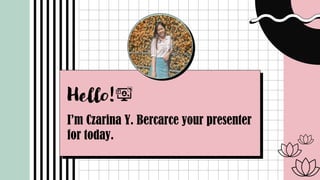
Unit III: Theories and principles in the use of design of technology driven lessons
- 1. Hello! I’m Czarina Y. Bercarce your presenter for today.
- 2. UNIT III: THEORIES AND PRINCIPLES IN THE USE OF DESIGN OF TECHNOLOGY DRIVEN LESSONS
- 3. • Edgar Dale (April 27, 1900 in Benson, Minnesota, – March 8, 1985 in Columbus, Ohio) • An American educator • One of his famous work was the Cone of Experience also known as the Learning Pyramid. Edgar Dale
- 4. SOME CONCEPTS OF THE CONE: 1. CONCRETE TO ABSTRACT- Experiences from the bottom are the most direct to student, and as it goes upward, the more indirect the learning takes place. 2. LEVEL OF ABSTRACTION- Seemingly, we can say that the manner of arrangement with accordance to the cone is from easy to difficult as the appearance suggests.
- 5. 3. PERCENTAGE OF RETENTION- Research says that the more skills involve during instruction, the better learning will take place. This also applies to the Cone which at the bottom (Direct Purposeful Experiences), study shows that 90% of possible information will retain. 70% both involves saying and writing, 50% on what we have heard and said, 30% on what we see only, 20% on solely hearing, and 10% on what we have read. As you will notice the percentage distribution, we can label them to the different bands of experiences. 4. DEVELOPMENT OF HIGHER ORDER THINKING SKILLS- The proper blending of concrete and abstract experiences will result the learner into developing his/her HOTS. The different bands can be maximized with one instruction depending on their usefulness. Don’t hesitate to provide the best experiences to your learner as possible as you can. There must be a balance always, not to spoon-fed, but not so carefree.
- 6. 5. BRUNER’S THREE-TIERED OF LEARNING- The Cone of Experience by Dale is connected to the idea of Bruner wherein he classified three (3) types of learners. • ENACTIVE LEARNERS- These are learners that learn from direct manipulation and application of concepts they have learned. They prefer experiences that involves the full utilization of their senses. • ICONIC LEARNERS- These learners learn best through printed visuals and auditory. Their level of cognition is quite honed that they can absorb slightly abstract concepts. • SYMBOLIC LEARNERS- Abstract Concepts and Ideas can easily be managed by a symbolic learner. They can quickly respond to any abstract instruction and form a mental image about something. An Enactive Learner would ambiguously respond to abstract scenarios while a Symbolic learner can comprehend it fully.
- 9. 1. DIRECT PURPOSEFUL EXPERIENCES- Most concrete learning experiences and direct to the learner. Hands-on activities, doing the real thing, and presenting a realia is an example of this. 2. CONTRIVED EXPERIENCES- Due to avaibility and cost effecitivity of some realias and the possibility of bringing them inside the class is unimaginable, we can use alternatives such as Models and Mock-ups. Re-enacting the real thing also considered as Contrived Experiences, just like Classroom Election of Officers. 3. DRAMATIZED EXPERIENCES- This learning experience is mostly appealing and fun in terms of implementation.
- 10. 4. DEMONSTRATION- This is showing to your students how to achieve a certain task with series of steps, then letting them take in the process. 5. STUDY TRIPS/FIELD TRIPS- In case you want to study concepts in which materials can’t be contained inside the class but possibly to visit, then study trip experience will best cater your students. 6. EXHIBITS- Exhibits are tagged also as collection of Mock-ups and Models contained in an area. These are usually “foryour-eyes” only but some are manipulative in nature. 7. EDUCATIONAL TELEVISION- This is also called as the “window of reality” as it lets you view some of the happenings in the past. It consists of continuously moving pictures paired with an audio.
- 11. 8. MOTION PICTURES- In contrary to Educational Television, Motion Pictures are series of continuously moving pictures but without an audio resemblance. 9. RECORDINGS, RADIO, STILL PICTURES- This type of experiences let’s you hone your imaginative skill and the senses involved in this stage were too minimal. 10. VISUAL SYMBOLS- Charts, Illustrations, Photographs, etc, are some examples of this phase. 11. VERBAL SYMBOLS- The most abstract and indirect learning experience of them all.
- 12. a picture reinforces the concept! Images reveal large amounts of data, remember: use one or more images instead of long texts
- 13. “What I hear, I forget; What I see, I remember; What I do, I understand.”
- 14. “Tell me and I forget. Teach me and I remember. Involve me and I learn.” -Benjamin Franklin
Hinweis der Redaktion
- to
- Edgar Dale once studied the use of Audio-Visual Media in instruction and mightily, he succeeded with his claims and brought new concepts in education. One of his famous work was the Cone of Experience which is visual model of different learning experiences consists of eleven (11) stages starting from the base up to the apex.
- According to Chinese Proverbs